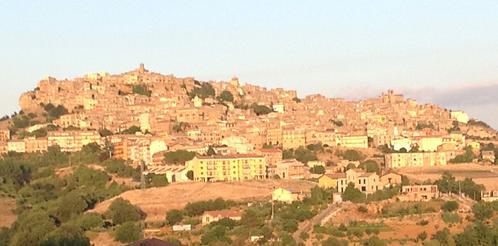Calascibetta in English
Calascibetta - 13/12/2012

On the mountain opposite the city of Enna, stands Calascibetta the town most closely linked to it. Built by the Arabs, it was given the name Kalath-Schibeth in order to fight and occupy Enna during the bloody wars between the Cristians and Saracens. The Arabian presence in Calascibetta is still evident today in the form of the socalled “Palio dei Berberi” which takes place on the first Monday of September. It is a sporting-folkore perfomance with its origins in the ancient Berber races. The town can be visited almost in one go, by going up and down the main street which runs through the town, and which will lead you to make an obligatory stop off at the splendid main church. Going beyond the imposing bronze doorway, you will come upon the impressive interior. The whole history of Calascibetta seems to have passed through here as can be seen from the ruins of an old castle in the church. The nave is very impressive, bounded by pillars in local red stone. At the base of the pillars, several carved figures capture one’s imagination and leave you reflecting on historical myths. The church’s immense treasure, including a large bible bound in leather and parchment, is temporarily kept in the diocesan museum in Caltanissetta. Once again outside, and going along the narrow streets of the historical centre, one immediately notices the many churches with stone facades, up until the last century, the town had forty six of them. These churches are today, the jewel case of this quiet town. Of particular interest is the Carmine Church, which houses a valuable painting of the Annunciation attributed to Gagini, the Capuchin Convent with a splendid 17th century altar-piece by Filippo Paladini depicting the adoration of the Magi and the church of Sant’Antoni, a fine example of the ancient Church of San Pietro attached to a Norman tower, later turned into the church bell-tower, is also worth mentioning. The three main monotheistic religions have, at one time, all been present in Calascibetta. It has seen both Arabs and Cristian but as you move through the ancient streets of the town, you will come across narrow, and almost inaccessible alleyways – these are the streets which made up the ancient Jewish quarter. A total immersion in western history.
On leaving Calascibetta, follow the 290 main road, for little more than one kilometre, and you will see signs for “Realmese”, a necropolis dating from between the 10th and the 6th centuries BC. Driving a few kilometres farther on and then a few metres on foot, pass by the disused stone quarry and you will come to the necropolis, easily recognisable by the many openings dug into the rochy mountainside. With silence as an accomplice, broken only by birds chirping and the the wind blowing, about three hundred kiln tombs, though preserving no signs of their past use, still leave one fascinated. A little further on from Realmese, is another necropolis, that of Malpasso, dating back to 2000 BC and made up of five burial caves.
